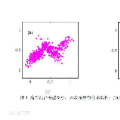We propose a precoder codebook construction and feedback encoding scheme which is based on Gaussian mixture models (GMMs). In an offline phase, the base station (BS) first fits a GMM to uplink (UL) training samples. Thereafter, it designs a codebook in an unsupervised manner by exploiting the GMM's clustering capability. We design one codebook entry per GMM component. After offloading the GMM-but not the codebook-to the mobile terminal (MT) in the online phase, the MT utilizes the GMM to determine the best fitting codebook entry. To this end, no channel estimation is necessary at the MT. Instead, the MT's observed signal is used to evaluate how responsible each component of the GMM is for the signal. The feedback consists of the index of the GMM component with the highest responsibility and the BS then employs the corresponding codebook entry. Simulation results show that the proposed codebook design and feedback encoding scheme outperforms conventional Lloyd clustering based codebook design algorithms, especially in configurations with reduced pilot overhead.
翻译:我们提议了一个基于高斯混合模型(GMM)的预编码代码构建和反馈编码计划。 在离线阶段,基站(BS)首先将GMM与上链接(UL)培训样本相匹配。 之后, 基站(BS)通过利用GMM的集群能力, 设计了一个不受监督的代码手册。 我们设计了每个GMM组件的编码手册条目。 在卸载GMM- 而不是代码手册到移动终端(MT) 后, MT 利用GM 来确定最合适的代码手册条目。 为此, MT 不需要对频道进行估计。 相反, MT 观察到的信号被用来评估GMM的每个组件对信号的负责程度。 反馈包括GMM组件的索引和最高责任, BS 之后使用相应的代码手册条目。 模拟结果显示, 拟议的代码手册设计和反馈编码计划比常规的基于Lyd集集的编码目录设计算法要优于常规, 特别是在实验性间接费用配置中。




